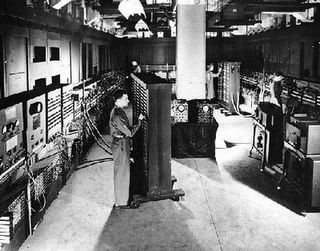
Another memorable day in the history of computing; today is the 60th birthday of ENIAC (Electrical Numerical Integrator and Calculator).
Regular readers of this blog will know that today's claim in News.com that ENIAC was the first electronic computer in the world is mistaken. That honorific title goes to the Colossus Mark I, officially installed in Bletchley Park, Milton Keynes, UK on January 31st, 1944.
Still, ENIAC was a major achievement. It was also a precursor to Moore's Law, in that it more than doubled Colossus's capacity two years after its predecessor's construction.
To do that, ENIAC contained 17,468 vacuum tubes (against Colossus' 1500), along with 70,000 resistors, 10,000 capacitors, 1,500 relays, 6,000 manual switches and 5 million soldered joints. It covered 1,800 square feet of floor space, weighed 30 tons.
ENIAC consumed 160,000 Watts of electrical power, making the lights go dim in Philadelphia each time it was powered up. I guess the people of Philadelphia should count themselves lucky that ENIAC's operating systems wasn't Windows.
On October 2, 1955 ENIAC was shut down for the last time. It had cost $486,804.22 to build, going 8 times over its initial (US Army) budget. Some things never change.





No comments:
Post a Comment